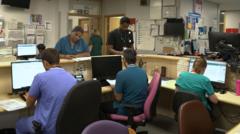Can This Hospital Solve Its A&E Crisis?

Transformations in Morriston Hospital's A&E: A Journey from Chaos to Calm
In recent months, Morriston Hospital's Accident & Emergency (A&E) department has undergone significant transformations, resulting in a marked improvement in patient care and staff morale. This article delves into the changes that have taken place in this vital healthcare facility, comparing the challenging conditions experienced earlier in the year to the current state of calm and efficiency. By examining the strategies implemented by the Swansea Bay University Health Board, we will explore how these improvements have directly impacted patient experiences and staff satisfaction.
The State of A&E: A Look Back at January
In January, Morriston Hospital's A&E department was caught in a whirlwind of overwhelming demand. The scene was chaotic, with patients lined up on trolleys and ambulances waiting outside, unable to offload their patients due to the lack of available beds. Reports indicated that the department was on the verge of declaring emergency measures, as 85 patients were waiting for a bed and one individual endured an agonizing 44-hour wait on a plastic chair.
The Impact of Winter Pressures
Winter is traditionally a challenging time for hospitals, with heightened demand due to seasonal illnesses and injuries. However, as Deb Lewis, the health board's chief operating officer, emphasizes, the pressure is not exclusive to winter months. In fact, official data showed that while January saw 6,659 patients attend the A&E department, June's figures rose to 7,287, indicating that the demand remained high even with the change in seasons.
Changes Implemented: A Multi-Faceted Approach
In response to the overwhelming circumstances, Swansea Bay University Health Board undertook a comprehensive review of their processes. According to Ms. Lewis, there was no single solution to the crisis; rather, a combination of four or five strategies proved effective. These changes have led to a 127% improvement in ambulance handovers within 45 minutes, a 72% decrease in lost ambulance hours, and a 20% reduction in the time patients spend in the emergency department.
Transformative Effects on Staff and Patient Experience
With the implementation of these new strategies, the atmosphere within the A&E department has shifted dramatically. Senior charge nurse Tristan Taylor remarked on the noticeable change, stating that the environment is now "a lot quieter and calmer" compared to the previous January visit. The staff's ability to provide fundamental care has improved, enabling them to engage more meaningfully with patients.
Personal Experiences: Voices from the A&E
Patients have also expressed their appreciation for the improved conditions. John Hopkins, a 71-year-old patient recovering from a serious fall, noted how swiftly he was attended to, stating, "Within five minutes I was with a consultant." Another patient, Sonia Griffiths, echoed these sentiments, highlighting the attentiveness of the staff during her stay. She previously experienced the chaos of the A&E and now appreciates the calm atmosphere and the quality of care received.
Future Goals: Sustaining Improvements
Despite the progress made, Ms. Lewis remains cautious about claiming the A&E woes have been entirely resolved. The health board's agenda moving forward includes several critical goals: ensuring that consultants are available at the front door of A&E seven days a week, optimizing patient discharge processes, and reducing ambulance handover times to an ambitious 15 minutes. Moreover, the aim is to reduce the time patients spend in A&E to within the 12-hour target.
Why Continuous Improvement Matters
Continuous improvement in healthcare is vital for maintaining patient safety and satisfaction. As the demands on the A&E department grow, the need for effective strategies becomes even more crucial. The changes implemented at Morriston Hospital serve as a valuable case study for other healthcare facilities facing similar challenges. By focusing on patient flow, staff support, and efficient processes, hospitals can better manage their resources and provide high-quality care.
Key Takeaways
- Morriston Hospital's A&E has seen significant improvements due to strategic changes.
- Staff satisfaction has increased, contributing to better patient care.
- Future goals include further reducing patient wait times and enhancing service efficiency.
FAQs
What specific changes were implemented at Morriston Hospital's A&E?
The changes included improving patient flow processes, optimizing ambulance handovers, and enhancing staff resources and support systems.
How has patient experience improved in the A&E department?
Patients have reported shorter wait times, more attentive care from staff, and a calmer atmosphere during their visits, leading to higher satisfaction levels.
What future improvements are planned for Morriston Hospital's A&E?
Future goals involve ensuring consultant availability seven days a week, optimizing patient discharge protocols, and further reducing ambulance wait times and patient stays in the A&E.
In conclusion, the journey of Morriston Hospital's A&E department from chaos to calm illustrates the power of strategic change and dedicated staff. As the health board continues to build on these improvements, it raises the question: how can other hospitals adopt similar strategies to enhance their emergency services? #HealthcareReform #PatientCare #EmergencyDepartment
Published: 2025-07-30 22:05:14 | Category: wales



